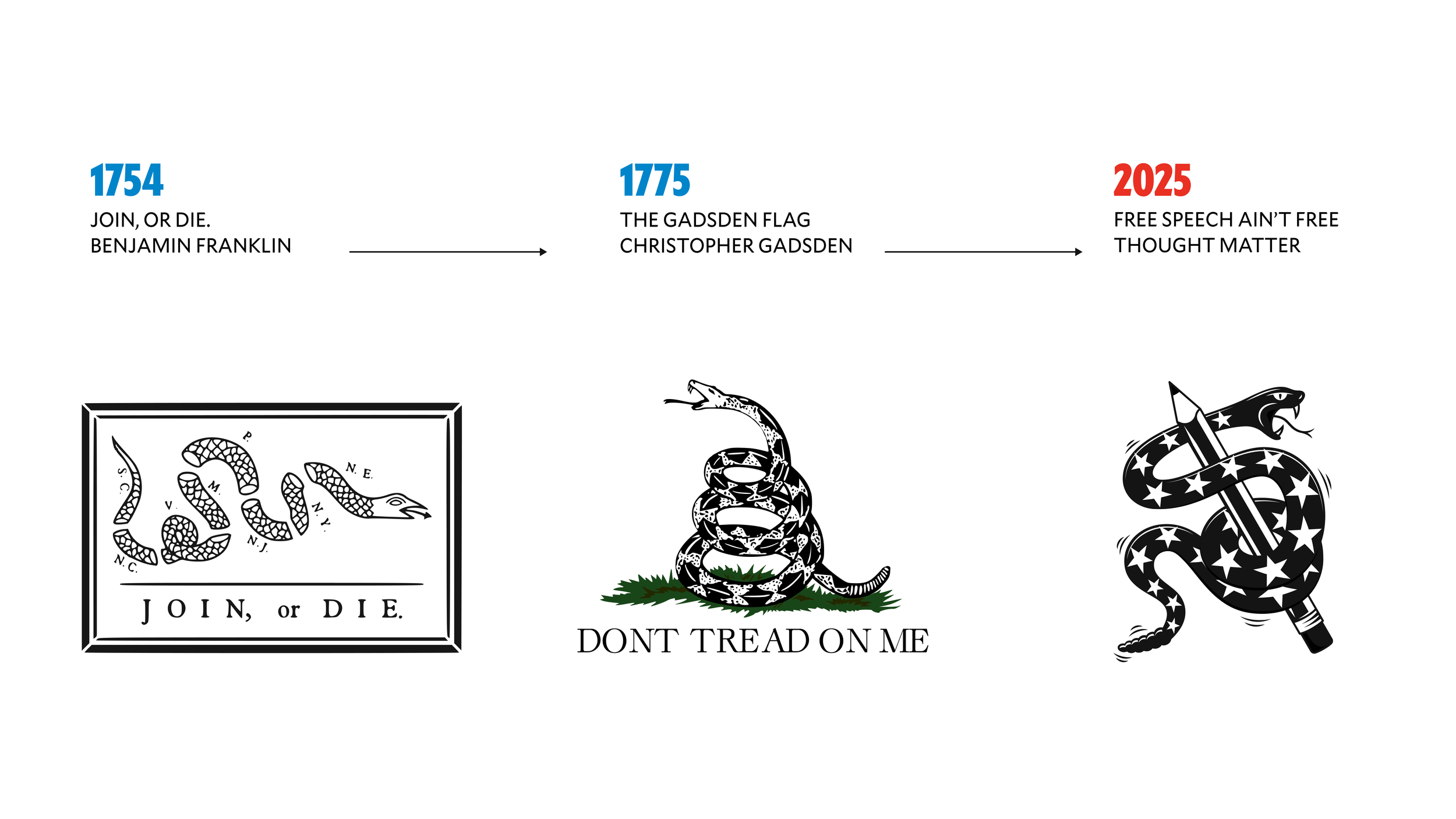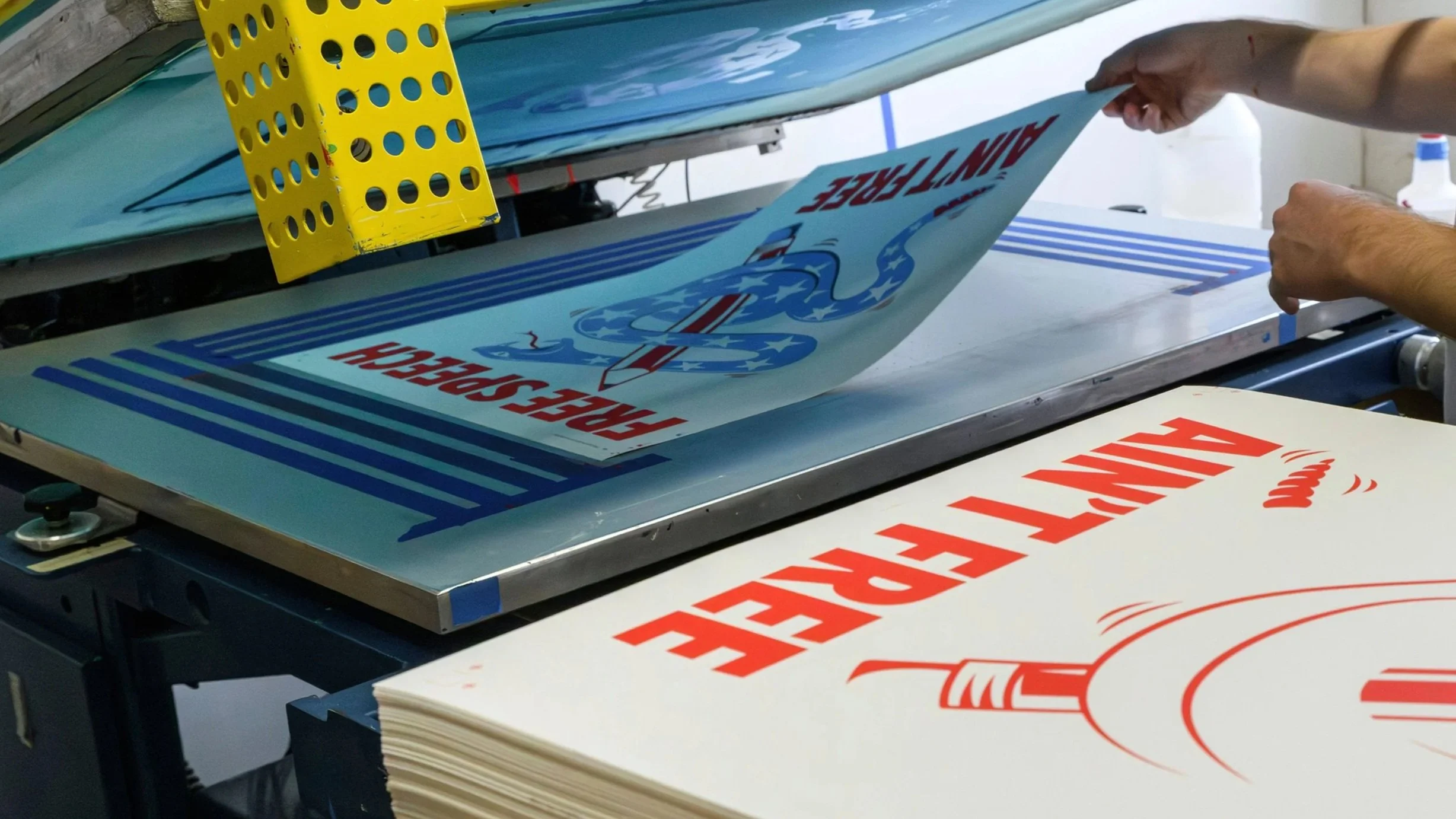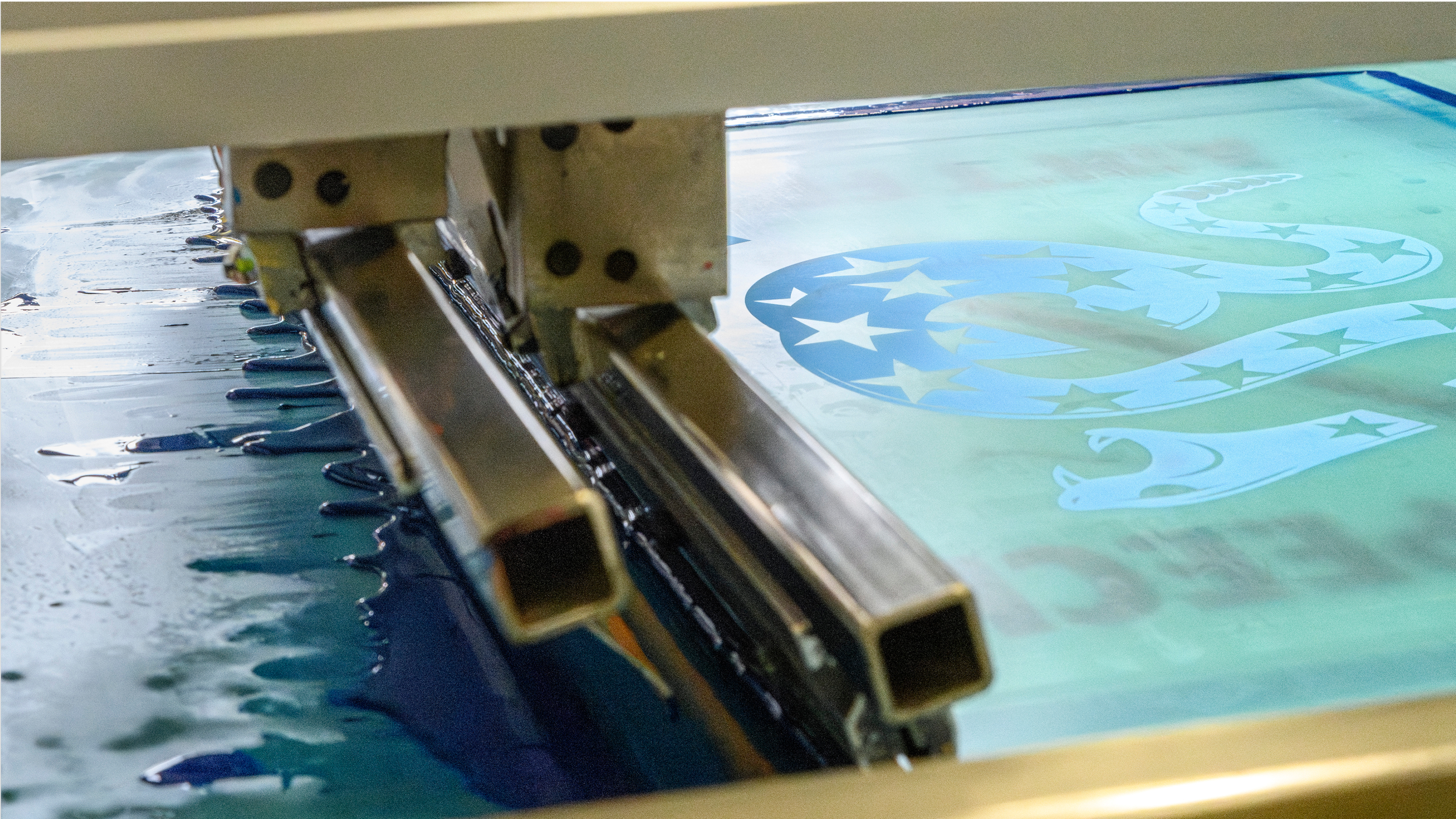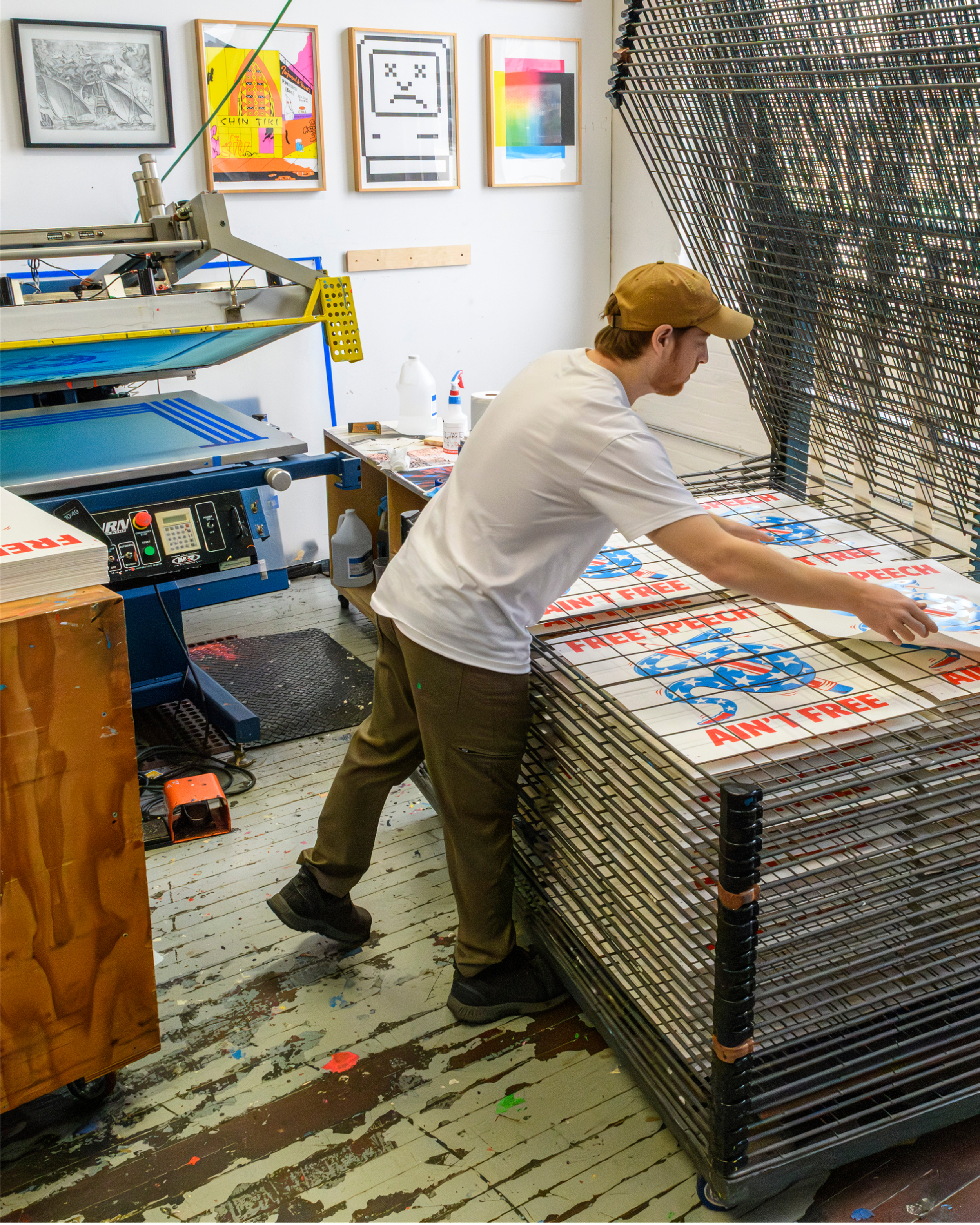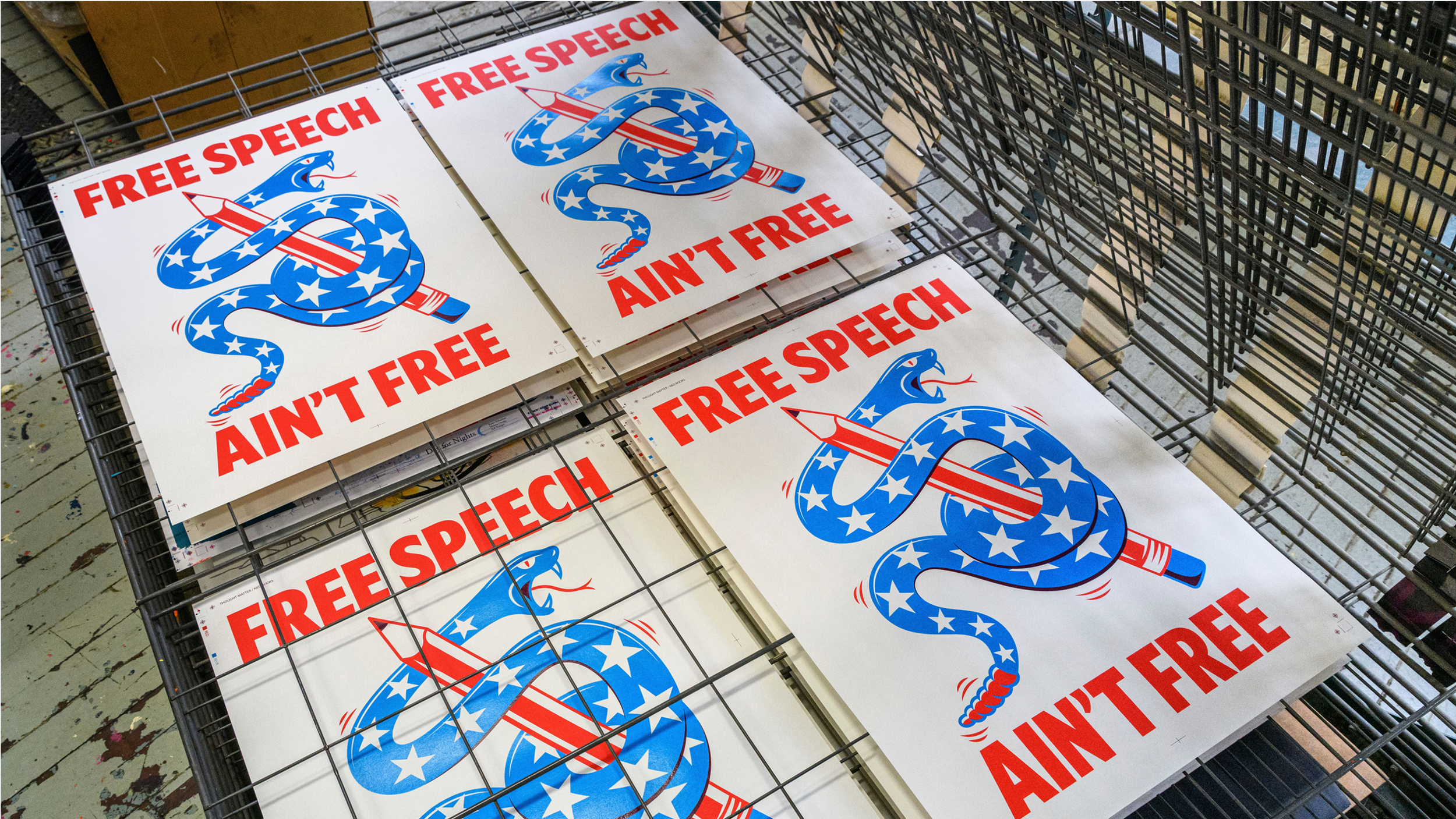READ WHAT THEY FEAR. FIGHT LIKE NOTHING’S FREE.
Censorship is here. It’s real. It’s happening right now. As designers and as citizens, we can’t afford to sit out the fight.
As Banned Books Week approached, we knew we had to confront power with the skills, tools, and energy we have in tow. We decided to extend the momentum of our CENSOR THIS! event by partnering with indie bookstores and community book spaces across all five NYC boroughs to give away our new, limited-edition screen printed posters. Declaring “Free Speech Ain’t Free,” the poster features a rattlesnake coiled around a pencil; a reclamation of revolutionary American iconography from Benjamin Franklin’s Join, or Die. and the Gadsden flag’s Don’t Tread on Me. Historic symbols meant to warn of tyranny now defend the freedom to read at present.
five Boroughs
five Bookstores
600 Limited-Edition Posters
Our partner bookstores embody the diversity and importance of New York’s literary ecosystem.
Brooklyn
Books Are Magic: A beloved family-owned business with two shops in the borough.
The Bronx
Bronx Bound Books: A bookmobile bringing literature directly into neighborhoods in need.
Manhattan
Word Up: A multilingual, collectively-run community hub.
Staten Island
Every Thing Goes Book Cafe and Neighborhood Stage: The borough’s only independent bookstore.
Queens
Kew & Willow Books: Independent, woman-owned and operated bookstore, founded through community crowdfunding after all Barnes & Noble locations in the borough closed.
The posters are more than keepsakes. They are vessels of meaning, designed to be shared and displayed as acts of cultural resistance. In a year defined by escalating bans, silenced media voices, the misappropriation of patriotism and faith, and a government shutdown currently underway, we believe design must get off the screen and into the world. Posters are tangible reminders that democracy erodes when symbols are surrendered and stories erased.
History Doesn’t Wait. Neither Do We.
We’ve been here before. As a studio, we took to the streets to fight for women’s rights during Trump’s first administration. We redesigned and printed the Constitution to remind students and artists that these texts were meant to protect us, and that we cannot afford to lose them. We worked with nonprofits to highlight needs ignored by those in power. We use art and design to show that communication is never neutral; it is always designed and shapes how rights are remembered, or erased.
When 2025 began, the country was moving into Donald Trump’s second term. Soon after, women’s rights were rolled back. Communication became a weapon to distort truth and vilify entire communities. Technology fractured the country, feeding lies to millions and replacing connection with manipulation. We watched Trump win again, but we were determined not to let history repeat itself. Instead of retreating, we sharpened our resolve. We stepped back into the fight.
In May of this year, NYCxDESIGN Festival declared the theme “Design is for Everyone.” At the same moment, headlines screamed of ICE raids and the banning of words and ideas in the press, on government websites, and in grant applications. We knew we needed to push back. We created CENSOR THIS!, a one-night-only, fully immersive event dedicated to exposing censorship as the most critical issue facing design and communication today. Two hundred designers and co-conspirators entered our studio and confronted a “Dead Library” of banned books, experiencing what it means to see literature erased in real time; rediscovering the urgency of defending our right to read. It was visceral. It was a reminder that none of us can afford to be passive. Steven Heller took notice and covered it in The Daily Heller. We knew we’d struck a nerve.
This past summer, Alexis, our high school intern and IB diploma candidate, transformed the Thought Matter studio into her own laboratory of imagination. She created a speculative fashion piece: a reusable bag for carrying banned books, sewn from the pages of a destroyed book itself. The prototype challenged her peers to hold their books close, to protect them, and to carry their right to read as a visible act of defiance. Her work affirmed two of our beliefs: the next generation refuses to be lied to, and creativity is a tool of dissent.
Imagination as Resistance
Throughout history, censorship has carried devastating consequences. Nothing good happens when power is concentrated by a few at the expense of the many, when speech is silenced, when societies forget their agency. Tyranny thrives in that darkness. Design can’t legislate, but it can illuminate. It can rally collective imagination toward resistance.
As we near the end of 2025, we stand where we started: fighting with pencils, pixels, and design. Our work is small compared to the scale of the threat, but every gesture of defiance matters.
Free speech ain’t free.
Read what they fear.
Artfully printed by Kayrock Screenprinting in Brooklyn.
FEATURED IN
WHEN DEMOCRACY IS IN CRISIS, DESIGN IS A WEAPON
History has shown us that moments of crisis are also moments of opportunity, when movements rise, voices unify, and action takes shape.
We’re in one of those right now. Public institutions, schools, museums, libraries, and cultural spaces are all under attack. This is not, however, a time to rest, give up, or wait to see what happens. It is instead a time for trust, and a little bit of risk.
For decades nonprofits, cultural organizations, and public institutions have helped shape the infrastructure of civic engagement and social progress. This, despite being chronically underfunded, overextended, struggling to cut through the noise, and now battling the threat of no government support whatsoever.
In the present era of deep mistrust and misinformation, how, then, to make these organizations not just heard but trusted once again? I believe design has a lead role to play in that fight. Strong branding, clear messaging, and bold visuals can build credibility, mobilize action, and ultimately strengthen democracy itself. As the leader of a design and creative studio, I don’t just believe we can participate; I believe we have an obligation to design change.
At ThoughtMatter over the past decade we’ve created protest posters raised high in marches, visual identities that amplified nonprofit missions, and branded spaces to redefine some of New York’s most iconic public places. Through this work, we’ve seen firsthand that design isn’t just an aesthetic choice; it’s an infrastructure for influence.
But we’ve also seen how misunderstood design can be. I’ve worked with organizations where a communications leader eager to build a strong brand hit only resistance from boards demanding immediate results. Branding is often mistaken for marketing, seen as something fleeting rather than structural or foundational. But when a brand lacks emotional resonance, it struggles to grow its audience, engage younger funders, or effectively tell the story of its impact. Design can change that—because great branding, at its core, is art in action.
Art has always paved the way for change. It has flowed freely through society, shaping cultural movements and expanding collective imagination. Today, we see this everywhere—from musicians testing the boundaries of symbolism on the world’s biggest stages, and fashion houses making bold political statements, to digital activism transforming public art into protest and resistance.
Over the years, I’ve been asked: Why would a branding studio invest in projects that don’t overtly feel like branding? I’ve come to realize that expansive, imaginative thinking is what changes minds. It enables people to see something in ways they never have before. That’s why we push and pull the levers of art, experimentation, and cultural commentary. Because real branding doesn’t just reflect the world as it is; it envisions what it could be.
Some of our most ambitious work has been rooted in this belief:
A mural promoting reproductive freedom — a critical ballot issue for the 2024 election cycle — by reinterpreting a controversial 150-year-old classical painting.
The Shithouse Artist series, creating space for employees to explore identity through expression and advocacy, as a response to Trump’s brazenly racist reference to certain countries as “shitholes” in 2018.
Our 2017 redesign of The US Constitution, coming after a divisive and disheartening 2016 election, followed by a docuseries about its role in creative life.
Digital graffiti projections during the pandemic, highlighting the impact of COVID on mental health through experiential visual representation.
Democracy Is Being Undesigned Right Now.
Many nonprofits believe what they need most today is visibility. But in a digital landscape oversaturated with calls to action, visibility alone isn’t enough. Nonprofits don’t just need to be seen; they need to be understood as trusted, effective and resilient. That means investing in branding as a form of capacity-building. It means crafting messaging that is clear and compelling. It means designing campaigns that don’t just go viral, but drive real-world impact. It means treating branding not as an afterthought, but as a strategic tool for long-term influence and as a point of differentiation.
We have a choice: allow institutions, policies, and cultural spaces to be reshaped by forces that suppress and divide, or take control of the narrative. This is our moment to build brands that unify, design campaigns that mobilize, and create messages that inspire action.
At ThoughtMatter, we will continue to focus our efforts in support of nonprofits, cultural organizations, and public institutions in order to build brands that embody ideas and values that stand the test of time. Whether it’s crafting a campaign that mobilizes voters, designing an identity that attracts funders, or creating a digital presence that strengthens community engagement, we believe branding is activism.
We are ready to fight alongside those who refuse to accept the erosion of democracy as inevitable. Because in times of crisis, imagination isn’t just an escape; it’s the foundation of action. We believe imagination is a radical act that can transform the world.
SPEAKING EXPERIENCE INTO CARE
How women are challenging stigma to redesign health & wellness solutions.
HOW WOMEN ARE CHALLENGING STIGMA TO REDESIGN HEALTH & WELLNESS SOLUTIONS
Let women live. In 2024, these three words are a common exhale. Expressed with equal parts adamance and exasperation, it’s an idea that not only resonates with more than half the world’s population but is reflected in both progress and setbacks across nearly every industry and field. But within the systems at play, can they? Even as women’s health gains recognition, stigma continues to threaten underserved needs. For women, defined here as anyone aligned with the female physical experience, healthcare remains a prevailing barrier.
Sexual wellness is on an upward trajectory and femtech is the buzzword of the moment. Yet for women looking to treat everyday needs, available solutions largely fall short of meeting the conditions they’re designed for. Take the 10 years it typically takes for a proper endometriosis diagnosis, no matter that 190 million women and girls worldwide suffer from this cause of chronic pain (Fast Company). Women are more likely to be at a disadvantage when seeking medical interventions due to lack of access, lower effectiveness, or both (McKinsey). It’s a disparity that extends from women’s health conditions to even such common ailments as asthma and cardiovascular disease.
But the imbalance doesn’t end with medical care. Visit a pharmacy or retailer and, in most cases, the wellness aisle can still be found prioritizing the latest immediate fix over dedicated options for health needs specific to women. Think dieting, energy pills, and endless cycles of cosmetic trends, over support for fertility and pregnancy to care for pelvic conditions and menopause. The typical assortment demonstrates the disconnect between where investment is coming from and going within the health and wellness sectors. Statistics show that only 2% of overall venture funding in health companies is invested in women’s health startups (Fast Company). Meanwhile, according to a recent study on the global wellness market in 2024, women are spending more of their own money on menstrual care and sexual health than any other categories of wellness products (McKinsey). It’s time for the health and wellness industry to get to know who it’s caring for — and to deliver on what they want.
Through unapologetic representation and open dialogue, rising brands led by women are building a blueprint to challenge the status quo. Nadya Okamoto, founder of the nonprofit PERIOD., began her company, August, in response to the deep-seated need for a sustainable, affirmative, and gender-inclusive period care brand. But meeting the immediate needs of people with periods is only the beginning. “I think there’s also a need to talk about overall period health — not just about period blood, but about all the related PMS symptoms too,” she affirms. And the efforts of Okamoto and others are boldly recontextualizing issues that have gone underserved. The fact that women are paying more attention to their underlying health and looking for solutions that promise long-term impact offers a mutual opportunity for brands.
Creating a caring consumer experience through visual identity and messaging to disrupt societal norms and industry conventions is an approach that can’t be overlooked. Reia, a brand that offers a modern-day solution for a widely prevalent condition, was founded on this awareness. Ariana Sopher and her co-founders were in college when they learned that 50% of post-menopausal people experience pelvic organ prolapse. And when they discovered how archaic most of the tools and medical devices used to treat the condition have remained, they committed to being part of a better reality for women. Prioritizing inclusivity and accessibility became important not only for the design of their device but across their entire consumer experience — a pursuit ThoughtMatter was proud to support. From the material and form of Reia’s pessary to the brand’s color palette and instructions for use, making the consumer feel supported was key, shared Sopher. “We want people to feel like we really thought about them every step of the way.”
For Alexandra Fine, founder of Dame, starting the dialogue to invite more people into the conversation is a powerful motivation. Dame made its name in products for pleasure, and as someone who built her career from a desire to talk about sex, Fine is committed to changing the way sexual wellness is understood. The brand also runs Dame Labs, which focuses on ‘people-centered research’, and Swell, a blog that explores ‘all things sexual wellness.’ Creating community through dialogue is something she’s seen both Dame’s products and platform empower.
The necessity of new healthcare solutions is becoming undeniable. There is a growing demand for brands that meet the needs of women, both in use and through thoughtful communication and design. Brands like PERIOD., August, REIA, and Dame embody this balance in a fashion that is intentionally bold and functionally focused. Meanwhile, innovation within the health and wellness sector is finding support at the national level. At the end of 2023, the White House announced the Initiative on Women’s Health Research, emphasizing the importance of tailored research, support, and future resources for women (Forbes). And the math adds up. Addressing the women’s health gap could add years to life for women, not to mention a better quality of life, and potentially boost the global economy by $1 trillion annually by 2040 (McKinsey).
It’s a classic case: Women deserve the same quality of care as anyone else. But this doesn’t necessarily mean the same care. Instead, women are looking for treatment options they can access, trust, and rely on. The health and wellness industry’s understanding of underserved conditions can be deepened by first-hand knowledge from the very people who are looking for ways to feel better. It’s an approach to healthcare that stands to transform the industry for us all. But for women, and others with underserved needs, it’s a state of care that’s long overdue. Because we don’t just want to live. We want to live well.
CREATIVE VISION
Celebrating the Black artists who inspire our studio’s perspective.
Celebrating the Black artists who inspire our studio’s perspective.
At ThoughtMatter, we challenge the premise that art relies on notions of beauty. Instead, we endorse the idea that it exists for a higher purpose — to provoke. Art calls us to attention and demands we take note. It cultivates compassion, conveying awareness through a unique language of ideas and emotions. Most importantly, it brings us into the stories it shares.
In our pursuit of creativity, we believe that the ability to stir feeling, challenge viewpoints, and evoke thought is imperative. Our commitment to being a studio with an artful perspective is driven by our belief in art that has something to say — especially from individuals who have been systematically silenced or have gone unheard.
Through a closer look at the art that inspires us throughout the year, join us in celebrating the perspectives of the Black artists that share our studio and how they inspire us to expand and deepen our creative practice.
THOUGHT MATTER ENTRY WAY
HEW LOCKE
Hew Locke turns a critical eye across his work to the ‘heroes’ who have inspired public monuments, and how society’s continuous evolution shifts our understanding of the power dynamics that lifted their legacies.
Informed by his Guyanese-British heritage, Locke’s own monumental creations disfigure Western history to call attention to these flawed narratives. He layers time through visual juxtapositions or by reworking pre-existing imagery, seeking to re-contextualize people who were formerly lionized.
One such example is Locke’s “Stuyvesant” (2018), a sculptural photograph of the last Dutch governor of the New Amsterdam colony. His is a name known across New York City, yet his involvement in the slave trade and antisemitism has only more recently been acknowledged.
In Locke’s recognition, Stuyvesant is presented in forbidding armor adorned with an intricate collage of skeletons and skulls. The result is a figure who is much more fearsome than revered, acknowledging the many lives unjustly harmed and too long forgotten.
LAVAR MUNROE
In fantastical landscapes of highlighter hues, Lavar Munroe converges narratives of personal, historical and mythological conception. Inspired by his upbringing in the Bahamas and travels throughout Africa, his work often expresses the conflict between a desire to escape and a longing for home — challenging curious onlookers to journey beyond the familiar.
Landing between painting and relief sculpture, “Land That I Heard Of Once in A Lullaby” (2023) depicts the experience of displacement through unexpected imagery. Recently awarded a Guggenheim, Munroe both grounds and abstracts the adversity faced by migrants seeking survival around the world.
LEBOHANG KGANYE
Though primarily a photographer and visual artist, Lebohang Kganye tells stories of home, refuge, family and identity. Born, raised, and currently based in South Africa, her work relates intimately to the enduring impact of Apartheid and the Bantustan people.
Enlisting oral tradition as source material, Kganye explores the familial history of herself and others to re-enact ideas of home and belonging. Composed of artfully collaged elements, the black and white scenes found in works such as “Never light a candle carelessly, from TellTale” (2018) and “O emetse mohala, from the Reconstruction of a Family” (2016) speak to the cruelty of a population forced to leave all they’ve known behind.
ROMÉO MIVEKANNIN
Roméo Mivekannin was trained as an architect, but notably began painting in 2019 after visiting a landmark exhibition at the Musée d’Orsay spotlighting the Black models portrayed in historic French masterpieces. In her book ‘Takedown: Art and Power in the Digital Age,’ journalist Farah Nayeri recounts the artist’s reflection on this experience. “I had an instant desire to relive the past, to put myself in those people’s place, to cross over to the other side of the canvas,” he explained. “I wanted to make the viewer confront history.”
Mivekannin’s own work pieces the past and present together through self-portraiture, replacing the faces found in colonial imagery with his own. He creates tension through converging representation: of now and then, of male and female form, of perception and reality, of a direct and subjected gaze. One such example is “Jeunes Filles Sénégalaises” (2021), which was created on fabric buried in soil to impart natural color, then illustrated with photographic and painted images that superimpose Mivekannin’s own face onto the bodies of young Senegalese women. Though visually arresting, the resulting piece of work bears many layers of intangible story. His work additionally recognizes his own family’s history as part of the royal Benin lineage, ancestors who fell from power as a result of colonizing forces.
JEAN-DAVID NKOT
Jean-David Nkot is a painter of the human condition of which “PO Box the feet story” (2019) is a striking example. Showing a diagram of a densely-populated city and its streets from above, the painting gradually reveals the foot of Africa, referencing its people working in those environments who too often go unseen.
From his native Cameroon, Nkot has delved into the exploitation of raw materials in Africa and the economic and political stakes driving these industries since 2020. More recently, his work finds focus in fields of cotton, the cultivation of which he associates with the beginnings of capitalism. His paintings express the impact this crop has had not only on humans, but the environment.
Nkot brings to light the workers who toil in the shadows. He compensates for their lack of visibility through contemporary consideration, prompting his viewers to rethink the relationships we conduct between ourselves and with the planet.
MALALA ANDRIALAVIDRAZANA
The work of Malala Andrialavidrazana is inspired by moving from one place to the next. Raised in Madagascar before settling in Paris, she interrogates the barriers and interactions of culture through both abstract and figurative depiction. In doing so, her work presents a new language of considering history while simultaneously engaging contemporary issues and developments.
Her Figures series begins with maps to trace the complex consequences of empire-building in the 19th century. Elements of photography, collage, illustration and text are brought together to form a pictorial narrative of ‘movement, space and connectivity.’ “Figures 1899, Weltverkehrs und Kolonialbesitzen” (2016) is a resounding instance: a map of the world framed and reclaimed by the creatures it was meant to hold.
…
From the charted narratives of Malala Andrialavidrazana to the symbolic appropriation of Roméo Mivekannin, our founder Tom Jaffe has spent years collecting work by artists with a point of view. In surrounding our work with ideas often shied away from or seen as difficult to put into words, this art makes visible what we seek to continue to create — work that is launched by a passion for connection, fueled by purpose, and driven by the goal of a better world to share.
Amidst the artistry that fills our walls, we take note of the artists who seek to express themselves in the face of adversity, recognizing the creativity that has prevailed against injustice and oppression.
Together, our embrace of visual communication is a generous act that connects us at our core. It’s said a picture is worth a thousand words, but perhaps the true value of imagery still lies in what the artist hopes to convey.
INVITED TO THE TABLE
There’s a moment after taking the first bite of a meal when our taste receptors begin their run of show. Salt punches in at the tip of the tongue and acidity kicks in on the sides of the mouth as the bitter notes rush to the throat. As the flavors start to take hold, our reaction can often be emotional: recognition, a surprise, a sense of delight, a savory satisfaction. This is food’s universal facility, a promise that exists before function or form.
Food is a great unifier. We are born asking to eat, and throughout our lives this essential function brings us together. We arrive at table or window or counter for a first whiff of smells strange and familiar, impatient for the satisfaction ahead. In its provision, preparation and anticipation, people have eagerly converged through the ages, creating time and space for community and kinship.
These days, the pace of life often leads us to reach for our food — from restaurants and premade services to markets and grocery shelves. Whether through a comforting readymade recipe, a new eatery featuring less traveled cuisine, or a global ingredient found locally, these offerings provide exciting opportunity. The branding of food is a powerful force when it speaks to an individual so deeply that it is possible to see a reflection of themselves; an extension of their identity, personality, or needs. A new taste or recommendation becomes an invitation to understand who someone is and where they come from.
In many of its favored forms, food is steeped with nostalgia. From the salt or sugar overload of a childhood treat to the improvised meals of adolescent living, we gather a treasure trove of timeless flavors as we move through life. Recreating a memorable dish is a way to travel across time and place, often finding form as the traditions and heirloom recipes a family or community passes down.
Yet the meaning of food can evolve, especially at the personal level. For first-generation Americans, individuals born to one or more parent coming to the US from abroad, a unique existence between cultures is exemplified in the convergence of traditions and flavors. Fragrant lunch boxes full of ingredients found beyond the typical grocery store shelves can be isolating, while American childhood food traditions might feel foreign growing up in a multicultural home.
One such example is Kolkata Chai, founded and run on New York City’s Lower East Side by two first-generation Indian American brothers. Across South Asia, sipping chai is a ritual found routinely in family homes, but also in tea shops and along bustling streets. It’s a cultural mainstay familiar across the diaspora, often paired with shared company and snacks. Inspired by this awareness, Ayan and Ani Sanyal began the café with a simple idea: “How do we extend the authenticity, respect and tradition behind a cup of masala chai to NYC?”
With bold, colorful branding and innovative offerings like seasonal soft serve and oat milk variations, Kolkata Chai is not inauthentic but rather expansively inspired. Creating a brand experience true to a multicultural lived experience has brought a timeless drink to new tastebuds. What remains consistent is what draws crowds of caffeine and culture lovers alike — the warm welcome of ginger, cardamom, black tea and milk.
In brick and mortar and beyond, food brands are embracing this fusion of cultures and cuisines with growing momentum. In 2023, Food Business News predicts the rise of ‘mosaic’ cooking, the continued convergence of regional and global flavors. Autobiographical diaspora cooking, another approach in focus, refers to chefs bringing together American foods with heritage recipes.
The diversity and adaptation embodied by first-generation and multicultural American identity is inspiring new ways to expand our palettes. Brands like Omsom, which offers a full spectrum of pantry starters for Asian dishes, and Diaspora Co., a fair-trade spice company, create ethical access for consumers to make beloved or discovered dishes their own. Both also pair iconic flavors with equally bold brand expression and visual representation across platforms, embracing their positioning by challenging stereotypes around food and its origins.
Food is a way to show appreciation for the culture and traditions of others. When we are invited to such a meal, we step beyond our own experience with an innate curiosity that’s often obscured. Eating together lets us experience stories that extend far beyond one place or person. Being offered a seat at the table, a phrase today imbued with contended meaning, is remembered around a meal as a humanizing gesture of acceptance and good will. There is something immeasurable to value in the everyday actions we engage in ritually and often choose to share. Through food we celebrate the beauty of living together while embracing our differences, and the expansive possibility of continuing to open the door.
A META-FREE YEAR IN REVIEW
HOW AN EXPERIMENT IN CUTTING TIES CONTRIBUTED TO OUR STRONGEST YEAR YET
Why are we here? When we asked ourselves that question, it wasn’t out of existential pandemic-induced dread but out of plain, old-fashioned curiosity.
Facebook and Instagram, the “here” in this scenario, were platforms we’d participated on since the inception of our studio because, well, weren’t we supposed to?
As a business, especially a creative one, it’s where we were meant to showcase our design chops, grow our brand, connect with our community, generate new business, and show people who we really are. Right?
Throughout the years, as a small independent studio we spent valuable hours creating for and experimenting with these platforms. We learned a lot, developing content we certainly were proud of. But at what cost? Or perhaps more interestingly, for what value?
Yes, to a degree you can measure how much impact your social game has on your business with the same KPIs that it seems everyone uses, but how can you really measure success without a good old A/B test. We’ve had years of A’s, in 2022 it was time for a B.
“We’re going on a learning journey,” we wrote, “and you are all invited.” With that, we stepped back from Instagram and Facebook with an invitation: Not to join our pause on participating with these platforms, but to follow us as we shifted our attention elsewhere.
We value community and have dedicated ourselves to working with organizations who do the same. We wanted to take a year to explore how we could better prioritize community building over content creation, while having the clarity and time to objectively observe how these platforms continued to grow and evolve. And that’s exactly what we did.
January 11th, 2022 was the last time we posted anything on Instagram or Facebook. And what a year it’s been.
HERE’S WHAT DIDN’T HAPPEN:
· We didn’t lose business (in fact, quite the opposite)
· We didn’t lose client trust (we heard zero criticism about the decision from our wonderful client roster and, better yet, worked on several social strategies for them)
· We didn’t lose followers (we gained them)
HERE’S WHAT DID:
· We explored Web3 and created identities for two of the biggest brands in that space
WORLD OF WOMEN
· we found community, a bountiful source of prospective work and meaningful engagement on LinkedIn
· we gave our team room to breathe and focus on client work and other internal projects (like commissioning Ukranian designers to create posters about the war that ended up at the Met, and designing our own poster as a call to action and ode to our hometown, New York City.)
UKRAINE POSTERS AT THE MET
“AN ODE TO NYC” POSTER
· we invested in making noise for music education, working with S’Cool Sounds and Mama Foundation to ensure young people had access to all that music has to offer
S’COOL SOUNDS
MAMA FOUNDATION FOR THE ARTS
· we created our own new platform AfterThought as means of investing in a consequential future for creativity through gatherings that explore the issues impacting creative life and work
THOUGHT MATTER MANAGING PARTNER JESSIE MCGUIRE AT OUR FIRST AFTERTHOUGHT EVENT
As the year comes to a close, we took a step back and asked ourselves, what should 2023 look like? Do we continue doing what we’ve been doing this past year? Was our Meta sabbatical just long enough for us to contribute to the platform again? And if so, for what purpose?
Here’s what we decided:
We’re jumping back into content creation for social media, but on our own terms. In the spirit of AfterThought, we’re reimagining how these platforms are traditionally used, and instead of leveraging them to generate awareness and clout, we’ll be using Instagram as a tool for contribution.
How? We’re busy building out a new content studio where, with the young design community in mind, the focus will be developing knowledge-sharing resources, inspiration and more. We won’t be on the ‘gram bragging about our latest work (for that, go to our website; it’s terrific), but rather sharing our knowledge and perspective to hopefully influence the future of design for the better. We’re in an industry controlled by long-established gatekeepers who for years have shaped and held the keys to the pathways into design. We plan to change that by continuing to open our doors, both IRL and virtually, to help young creative people better understand how and why they can and should design their careers in their own unique ways.
We’re ready for another experiment. Hope you’ll join us once more. See you in 2023!


